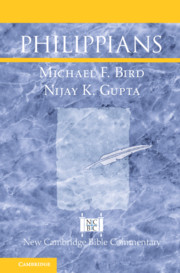Suggested Reading
Published online by Cambridge University Press: 16 April 2020
Summary
There continues to be a robust conversation going on in scholarship about what kind of letter category fits Philippians. Not long ago, a large number of scholars were convinced it is a “letter or friendship,” but there is more hesitancy today.
- Type
- Chapter
- Information
- Philippians , pp. 28 - 32Publisher: Cambridge University PressPrint publication year: 2020



